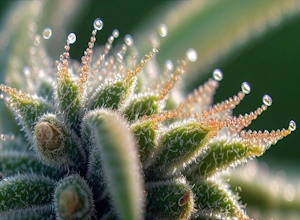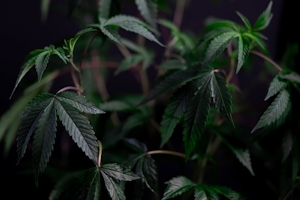
Photo by Reddit
What Is PGR Cannabis?
A call to remember that the best highs come from the ground, not the lab.
Entering the realm of cannabis cultivation, one might stumble upon the term PGR or Plant Growth Regulators.
These chemical compounds, similar to hormones in humans, play a key role in guiding the growth and development of plants, including cannabis. But as we delve deeper, a crucial question arises: “Is this something I want in my body?”
Here, we unravel the mystery behind PGR, exploring how it differs from organic cannabis and how these chemicals impact the plant and potentially your health.
What Is PGR In Plants?

Photo by Stock
Among the main actors in the PGR world are auxins, cytokinins, gibberellins, abscisic acid, and ethylene, each playing a unique role in plant physiology—from promoting growth and flowering to managing stress responses:
Auxins – the plant’s growth directors. They tell plants where to stretch and grow, help with root development, and ensure flowers and fruits form correctly.
Cytokinins – the fountain of youth for plants, keeping leaves green and delaying aging. They jump-start growth in new leaves and help seeds and buds wake up from their nap, ensuring everything looks fresh and lively.
Gibberellins – the plant’s growth booster, breaking seed dormancy and encouraging flowers and fruits to grow big and strong. They’re the secret sauce that helps plants stretch taller and fruits grow longer.
Abscisic acid – the plant’s stress manager, stepping in to slow things down and conserve water during tough times. It’s like a pause button that helps plants hunker down and survive until better conditions return.
Ethylene – the plant’s signal for change, triggering fruit ripening, leaf drop, and even helping flowers bloom. It’s a bit of a plant hormone multitasker, coordinating many of the changes we see as plants mature.
It’s important to distinguish between natural and synthetic PGRs. Natural PGRs work alongside a plant’s inherent rhythms, while synthetic variants offer growers precise control over their crops, including cannabis. However, this control comes with a caveat—potential exposure to chemicals.
Chemicals Found In PGR Weed

Photo by Matteo Paganelli
PGR weed often contains chemicals, which, while boosting plant growth, can come with a hefty price tag for health.
Common chemicals found in cannabis grown with PGRs include:
Daminozide
Originally used to regulate growth and extend shelf life in apples, Daminozide has found its way into cannabis cultivation. However, its association with serious health risks, including liver damage and cancer, raises significant concerns, especially for medical marijuana patients seeking natural treatment options.
Paclobutrazol
While effective in promoting dense foliage, Paclobutrazol is another growth regulator that has a dark side. When smoked, it can break down into nitrosamines, known carcinogens. This chemical not only compromises the safety of cannabis but also impacts its quality by reducing resin production, leading to fewer trichomes and lower cannabinoid levels.
Chlormequat Chloride
Although less recognized, Chlormequat Chloride shares similar risks with its fellow PGRs. It restricts plant height while promoting a bushier appearance. However, it also poses potential health hazards to consumers, including skin and eye irritation.
These chemicals, integral to PGR cannabis, underscore the trade-off between enhanced plant growth and potential health risks.
Being able to identify PGR-treated cannabis is crucial for consumers aiming to evade these chemically enhanced products. But how can one spot PGR weed? Let’s delve into the distinguishing signs.
How To Identify PGR Weed

Photo by Fast Buds
Distinguishing between PGR weed and organically grown cannabis is crucial for those who want to prioritize safety and quality in their cannabis consumption.
The use of synthetic PGRs in cannabis cultivation can dramatically alter the natural development of the plant, leading to several identifiable traits that differ greatly from organic cannabis.
PGR Vs. Organic
PGR cannabis often exhibits the following signs:
Excessive Red or Brown Hairs: An overabundance of brown and red pistils indicates a focus on rapid growth at the expense of natural PGR development and THC-rich trichomes.
Lack of Shiny Trichomes: A noticeable absence of the frosty, crystalline trichomes that are hallmarks of high-potency buds, resulting in PGR buds appearing dull.
Diminished Aroma: The rich, fragrant terpenes that define the aromatic profile of cannabis are largely reduced, leaving PGR weed with a very mild or almost non-existent scent.
Dense and Hard Buds: PGR vs organic buds can be easily differentiated by texture; PGR buds are unnaturally dense and hard, sometimes feeling like small rocks, unlike the fluffy and sticky texture of natural cannabis.
Spongy or Wet Texture: Contrary to the expected dryness of well-cured cannabis, PGR-treated weed may feel spongy or retain moisture, suggesting an unnatural growth process.
Chemical Flavor: Upon consumption, PGR weed may impart a harsh, chemical taste, a stark contrast to the complex flavor profiles of natural cannabis.
Reduced THC Levels: The psychoactive and medicinal efficacy of PGR cannabis is often compromised, exhibiting lower THC levels and a diminished spectrum of cannabinoids.
Quick, Unpleasant High: The effects of PGR weed can be fast-acting but lead to undesirable outcomes such as lethargy and headaches, diverging from the well-rounded and lasting high associated with natural cannabis.
Spotting these features can help consumers steer clear of PGR cannabis, which is often associated with health risks due to synthetic growth regulators. Opting for naturally grown cannabis not only safeguards personal health but also supports sustainable and responsible cannabis cultivation practices.
Can PGR Weed Kill You?
While the outright lethality might not be immediately obvious, PGR weed’s long-term effects cannot be understated. Organ damage, reproductive harm, cancer risk, and skin and eye irritation are just the tip of the iceberg when it comes to the potential adverse effects of synthetic PGRs. Research continues to grow to understand the depths of PGRs on human health.
The allure of PGR buds might be tempting for their aesthetic appeal, yet opting for natural or organic alternatives isn’t just a choice – it’s a commitment to your health and well-being.
Herb Recommended Products:
READ MORE










